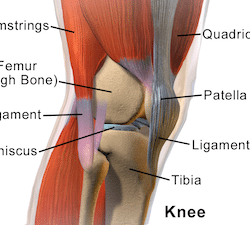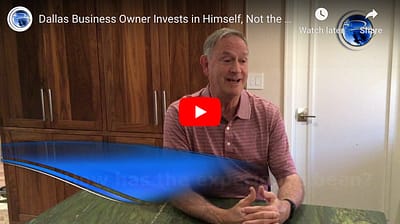Over 200,000 people a month search google for information on knee pain. Needless to to say, it’s a common problem. You may be surprised, however, to learn that the knees are seldom to blame for the discomfort experienced. I’ve outlined 5 of the most common sources of knee pain below, and some ideas to correct the root causes.

1) Far too much sitting
How does this affect your knees? You may wonder. I’ll explain. Your gluteus maximus is the antagonist to your hip flexors, the muscles that lift your knees upward toward your torso. As you sit on your glutes, they relax and lose tone, much like pressure point massage therapy. The hip flexors, on the other hand, get extremely short and tight with long periods of sitting, because of the 90* angle between your femurs (upper leg bones) and torso. This creates unnatural pulling and twisting forces when you do try to stand up, walk, jog, run, squat, or jump. Please note, I didn’t say they are too strong, just too short. They should be at least strong enough to do a full set of sit-ups or knee raises. But they need to be worked and/or stretched through a full range of motion, which includes hip extension. Walking is tremendous for accomplishing this, as one femur extends behind the torso as the other reaches forward for the next step. Strengthening the glute maximus muscles with exercises like lunges, hip bridges, and donkey kicks will help create tone in the glutes that will produce a constant gentle lengthening of the hip flexors.
2) No lateral hip strength
This is a big one, and it’s very common. When we were younger, we did jumping jacks, played foursquare and hopscotch, roller skated and swam, among other sports and activities. We actually moved our legs side to side! That strengthened a group of muscles called our abductors, which connect the outside of our hips to our upper legs. When we were younger, strong hip abductors kept our femurs (upper leg bones) from caving in toward each other. These days though, too many of us have lost that lateral hip strength, and therefore suffer knee pain due to misalignment of the bottom of our femurs with the top of our tibias (shin bones.) What was supposed to be a smooth-operating hinge joint has now become an uncomfortable mess of clicking, grinding, catching, and pinching. It’s not simply bad cartilage, old age, or too much weight. Those may be small contributing factors, but they don’t excuse a legitimate postural dysfunction. I promise you – the path that returns you to pain-free days with be filled with lateral strengthening movements like lying and standing side leg raises, hip hikes, single leg stands, side planks, and resistance band side steps. Keep in mind – if you let the foot rotate outward during these exercises, you will severely limit he effectiveness of the movements and fail to help yourself. So be sure to keep the angle of your feet parallel to each other throughout every exercise.
3) Shoes are too small
This is an all-too common mistake. People often decide whether or not a shoe fits based on the amount of room left in the toe while standing. That’s actually the least important aspect. It’s much more vital to make sure you match your arch length, and have enough room in the forefoot to move and splay your toes, including that neglected little toe. If you are going to use the foot-measuring device, make sure you measure both feet, and use the inside slide to measure your arch length as opposed to looking at total foot length. Many of us have lost some of the arch over time, resulting in a longer foot – but we are still trying to wear the size we wore 15 years ago! Give those toes room – lateral room. They help balance you and keep your knee aligned properly.
4) Externally rotated femurs
If we allow ourselves to become less coordinated and less athletic year after year, we will start to compensate for our lack of strength and balance with an altered gait. What do I mean? Visit a mall and just watch people walk for a while. You will see that we are starting look more like waddling penguins than gliding humans. Our legs and toes are turned out. Instead of simply moving forward, we end up fighting the other half of our body. The right side takes a step toward the right. The left side takes a step toward the left. Yet our goal is straight ahead! What a waste of time and energy. More concerning, however, is that this puts added stress on the knees. Both the toes and the knees should be pointed in the direction we are trying to move. Sometimes, just one femur is rotated. This can actually be caused by “toe-out” driving for long periods, where the heel stays under the brake but the toes are out over the gas pedal. This can add up if you spend a lot of time behind the wheel. If you are going to be on the gas for a while anyway, try moving your heel over underneath the toes. You’ll feel your femur internally rotate back towards normal, and your knee may be better for it. It’s a good idea to check yourself for symmetry e wry now and then, especially on road trips.
5) An unlevel pelvis
Perhaps you sleep on the same side every single night. Maybe when driving, you always lean into the center console. Or it could be you always carry a heavy briefcase or purse on the same shoulder. Any and all of these could add up over time to shorten the distance between your lower ribs and your hip bone on one side versus the other. We have 2 quadratus lumborum muscles that complete this connection – one on each side. If the right muscle is much shorter and tighter than the left muscle, the hips will be unlevel, often resulting in a short leg. (fyi, sometimes the shoulders and neck take the hit instead) This will add stress to the knees – sometimes the one on the “short” leg, sometimes the one on the “long” leg. Remember though, the problem is really in the core. The knees are just displaying the symptoms. Try sleeping on the other side, carrying your bag on the other shoulder, and/or leaning the other direction in your car for a while. Be sure to incorporate core exercises in your workouts, and challenge both sides with equal force. Stretching both sides with equal distance is another good idea. With equal force and distance, the weak side will eventually catch up to the strong side. Furthermore, total strength, balance, and flexibility will increase, making you less likely to develop the postural dysfunction again when doing necessary daily activities like sleeping in bed, carrying items, or driving your car.
So don’t be disheartened if you’ve been led to believe that irreversible damage in your knee joint is the cause of your problems and pain. The often thrown around “bone on bone” idea is VERY seldom true. If you can bend or extend your knee at all, you are likely not “bone on bone,” no matter what you’ve been told. And even if you’ve experienced some cartilage damage, your body can regenerate it given healthy alignment, exercise, and nutrition. You have cells called chondrocytes, and the pumping action that MOVEMENT and pressure creates actually stimulates the production of cartilage. As you can see, sitting around because you have knee pain only makes things worse. Take action, but take safe and smart action to begin your healing and strengthening journey. Contact us if you need or want help making it happen!



























